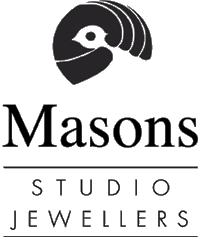The Artist
Phill Mason - The Education
Having been born and raised in Sydney, Phill ultimately wanted to attend the University of Sydney. In pre-Whitlam 1969, when"going to uni" was expensive, such an ambition meant having money or backing. Without a well-off family behind him, Phill had to study evenings for the first year, whilst working in the trenches of the Metropolitan Water, Sewerage and Drainage Board during the days.
Phill graduated from these trenches to the tunnels of the Snowy Mountains Authority Hydro-Electric Scheme for most of 1970, assisting welders at the Tumut III Power Station site near Talbingo. These experiences with the intersecting of pipes would become signatures of Phill's work in jewellery in the future. Full-time studies in Fine Arts commenced in 1971, in an unlikely combination with reading Honours Geography.

The three years of Fine Arts was a theoretical course undertaken through the Power Institute of the University of Sydney, which went on to become the basis of the Museum of Contemporary Art between Circular Quay and The Rocks in Sydney. Phill in 1970 in the Snowy Mtns.

Sports cars were always in the blood, but he's moved on: from red to white... So, studying Art was not a practical, hands-on training, but rather, an understanding of aesthetics and the history of art, as they applied to painting, sculpture, architecture and film.
Phill was privileged in those years to have lecturers of the eminence of Bernard Smith and Donald Brook, and Terry Smith as a tutor.
PREPARATION AND REPARATION
THE TRAININGAs a metalsmith, jeweller, lapidary, and stone facetor, Phill is self-taught. Of course, there were many helpful people and books along the way; but as a jeweller, he has had no formal training. Phill did not become a jeweller until the age of thrity three, after having been a teacher, and a restauranteur. His childhood love of rocks, and his high school enjoyment of metalwork, were both repressed by Ambition. But they ripened darkly and eventually flowered in mature adulthood, leaving Phill, by then with adult obligations, with no choice but to undertake daily exercises in silver soldering and fabrication, if he was to become a jeweller.
Using Australiana gumleaf as a design vehicle, Phill drove his skills to the point where they could be relied upon, and in 1985 re-hung his shingle, in Salamanca Place, Hobart, as a studio jeweller... The beauty of being self-taught was that Phill was not taught "what can't be done"; and learning a little later than training is usually undertaken, meant that by then he brought some small richness of experience to bear. In other words, he found he had something to say, and was able to develop his own way of saying it. |
WORKSHOPPING THE WAYAlong the way, Phill has been fortunate to take part in a number of workshops, given by notable jewellers, mainly under the auspices of the Jewellers and Metalsmiths Group of Australia. These workshops have included 'Low-Tech techniques' at SH800 Workshop, Java; 'Exploration of Form and Metal Patination', with Michael Rowe; 'Fold-Forming' techniques, with Charles Lewton-Brain; 'Japanese Metalworking' techniques, with Hiroko and Gene Pijanowski; Enamelling, with Jamie Bennet; 'Gold Leafing and Cold-Joining ' techniques, with Bruce Metcalf; and Case-Making, with Penny Carey-Wells. Phill's four exercises in the exploration of form and patination, a result of the Workshop under Mchael Rowe, covered in Craft Tasmania magazine 1986. "When does an arrangement of elements become a container? The patination is contained in the abstracted base of a 'can'..."
Phill was also fortunate enough to be able to occupy a studio-residency at Lakeside, Michigan, together with Carlier Makigawa, in 1992. This experience enabled him to play with scale, and fabricate pieces of two metres length. |
GIVING BACKIt is important to give back to the society that nurtures you. Phill has made himself available to serve a number of organisations, which were important to his craft, in an honorary capacity (ie without pay or gain). These have included ten years on the Board of the Salamanca Arts Centre (1986-96), with the last four of those serving as President, and representative on the State Government Oversighting Committee; President of the Crafts Council of Tasmania, and vice-President of the Crafts Council of Australia; National Chair of the Jewellers and Metalsmiths Group of Australia, and Convenor of the International Conference of the JMGA in Hobart, 1997 Phill has also taught Jewellery Fabrication in the Hobart TAFE for a half-decade in the late 'eighties, and continues to teach Gemmology in the Hobart Gemmological Association of Australia. In 1989-90 Phill was also responsible for a Trainee (Ms Jan Barker); and from 1995 Phill undertook the responsibilities of apprenticing his son, Tyrus. |




